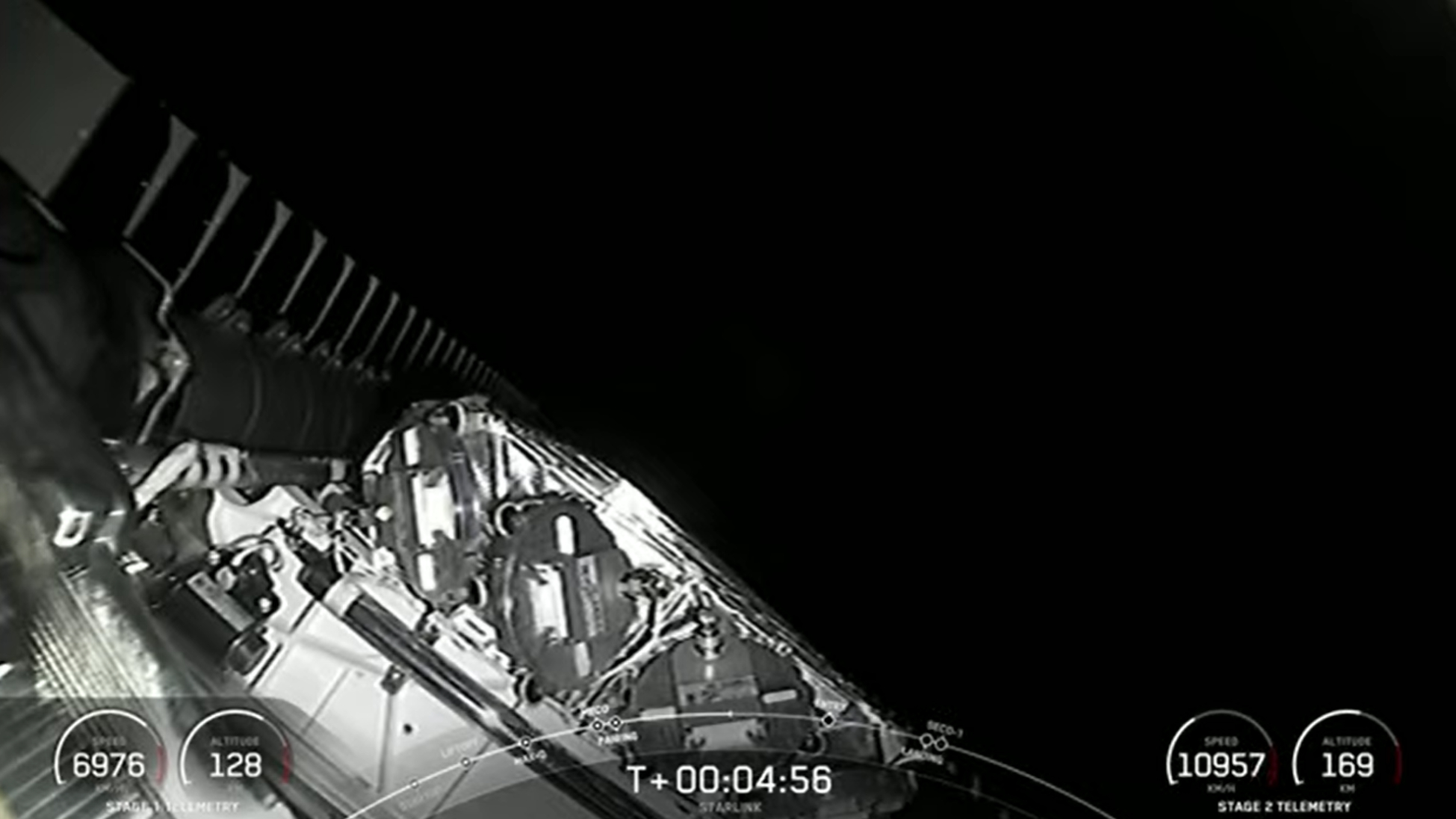SpaceX launches 54 upgraded Starlink internet satellites and nails rocket landing at sea in 60th flight of the year
SpaceX can now "deploy satellites to new orbits that will add even more capacity to the network."
SpaceX launched the first batch of a new generation of Starlink satellites into orbit early Wednesday (Dec. 28) and nailed a rocket landing at sea to mark a record 60th flight of the year.
A Falcon 9 rocket topped with 54 upgraded Starlink internet satellites — the first generation 2 (Gen2) versions of the SpaceX fleet — lit up the predawn sky with a smooth launch at 4:34 a.m. EST (0934 GMT) from the Cape Canaveral Space Force Station in Florida.
"Under our new license, we are now able to deploy satellites to new orbits that will add even more capacity to the network," Jesse Anderson, a SpaceX production and engineering manager, said during live launch commentary. "Ultimately, this enables us to add more customers and provide faster service, particularly in areas that are currently oversubscribed."
Related: 10 weird things about SpaceX's Starlink internet satellites

About eight minutes after liftoff, the Falcon 9 first stage returned to Earth with a landing on the SpaceX drone ship A Shortfall of Gravitas in the Atlantic Ocean, where rough recovery weather threatened to delay the launch. The touchdown marked a successful end to SpaceX's 60th launch of SpaceX in 2022, nearly doubling the 31 launches set as a SpaceX record in 2021.
The Falcon 9 first stage on this mission made its 11th flight with Wednesday's launch. The booster previously flew five Starlink missions, launched two U.S. GPS satellites, the Nilesat 301 commercial satellite and carried two different private astronaut crews on the Inspiration4 and Ax-1 missions, SpaceX has said.
The company will also attempt to recover the two payload fairing halves that made up the Falcon 9's nose cone, which had both flown before, for later reuse, Anderson said.
Breaking space news, the latest updates on rocket launches, skywatching events and more!
SpaceX's Gen2 of Starlink is said to be more powerful than the 3,300 or so working in orbit right now, and it appears SpaceX needs the bandwidth boost. The broadband network is facing congestion woes despite sending hundreds of first-generation Starlink satellites aloft this year, a recent SpaceNews report suggested.
"Starlink is a satellite internet constellation designed and manufactured by SpaceX to provide high-speed, low-latency internet to people living in remote and ural locations around the globe," Anderson said.
On Dec. 1, the Federal Communications Commission (FCC) granted approval for SpaceX to deploy 7,500 Gen2 satellites. That was just a partial approval, however, as SpaceX applied to the FCC for permission to send nearly 30,000 of these satellites to low Earth orbit.
Besides being able to handle more traffic, Gen2 satellites can beam service directly to smartphones, SpaceX founder Elon Musk has said. While this crop is going into space aboard a Falcon 9, SpaceX eventually plans to use its massive Starship rocket, which is in development and has been awaiting approval to fly to space for 18 months.
Editor's note: This story, originally posted on Dec. 27, was updated on Dec. 28 to include the results of the Starlink 5-1 launch and to correct the number of times the Falcon 9 booster has flown. It was its 11th mission.
Elizabeth Howell is the co-author of "Why Am I Taller?" (ECW Press, 2022; with Canadian astronaut Dave Williams), a book about space medicine. Follow her on Twitter @howellspace. Follow us on Twitter @Spacedotcom or Facebook.

Elizabeth Howell (she/her), Ph.D., was a staff writer in the spaceflight channel between 2022 and 2024 specializing in Canadian space news. She was contributing writer for Space.com for 10 years from 2012 to 2024. Elizabeth's reporting includes multiple exclusives with the White House, leading world coverage about a lost-and-found space tomato on the International Space Station, witnessing five human spaceflight launches on two continents, flying parabolic, working inside a spacesuit, and participating in a simulated Mars mission. Her latest book, "Why Am I Taller?" (ECW Press, 2022) is co-written with astronaut Dave Williams.

